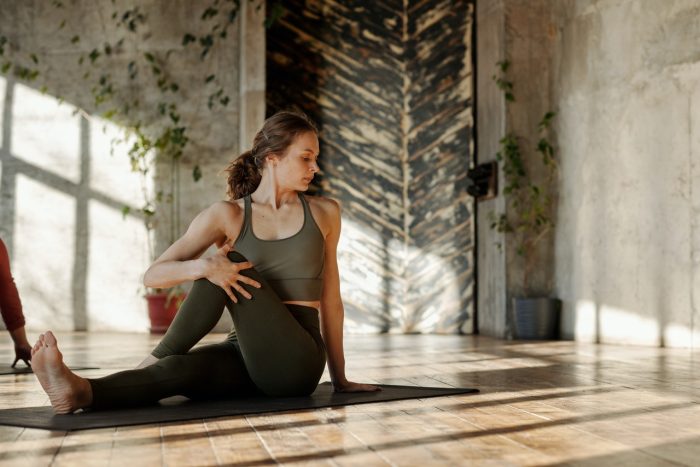People in our society are burdened by stress and trauma.
It’s no surprise that so many people come to yoga, meditation, and other body-mind practices in order to find relief and healing.
Unfortunately, many practices, like yoga, find their roots in a tradition that was not designed for psychological healing. That’s why there’s little education on psychology in yoga teacher trainings. While yoga has been applied to achieve physical health, it was originally conceived as a spiritual practice with little interest in diving into the human psyche.
The whole purpose of yoga was to still the mind in order to go beyond it so that we can discover firsthand our spiritual nature. And while feeling spiritually connected is an important aspect of mental health, it allows us to ignore and bypass our deeper-seated problems like unprocessed emotions, trauma, and unfavorable thought patterns.
Today, we are entering a new era where we are integrating ancient spiritual practices with modern insights on psychology to offer an integrative and holistic path to well-being and awakening. As yoga teachers, we have to educate ourselves more than ever on mental health and trauma in order to support students safely and efficiently on their path.
Most people today come to yoga to feel better. Whether that means to reduce stress, calm anxiety, manage depression, or recover from burnout.
So how can we make our yoga classes more therapeutic to support students experiencing stress, anxiety, depression, and burnout even better?
If you’ve been teaching yoga for a while, you’ve noticed how healing yoga can be. But here’s the thing. Even though yoga can be incredibly therapeutic, the way in which we teach and practice yoga can also have adverse effects on our mental health.
The first thing that we need to learn in order to teach yoga classes that meet the emotional, mental, and therapeutic needs of students experiencing mental health challenges is how to be trauma-sensitive.
Many people don’t realize this, but most of us hold some degree of trauma. Trauma is the result of a deeply distressing or disturbing experience that overwhelms an individual’s ability to cope, with lasting adverse effects on the individual’s functioning and mental, physical, social, emotional, and/or spiritual well-being.
Adults who experienced trauma in childhood are often “wired” differently than those who did not. Their brains, primed to deal with nearly constant stress, can struggle to respond appropriately to situations that would otherwise appear normal and nonthreatening. This partly explains why many adult trauma survivors struggle with depression, anxiety, and other issues related to emotional regulation. These resulting mental health issues can contribute to long-term difficulties maintaining healthy relationships and lead to problems at school and/or work.
When we practice yoga, we’re asked to connect deeply with our bodies, and we become more aware of what’s really happening inside of us. This can be confronting. It can put us face-to-face with old memories and bring unprocessed feelings to the surface. That’s why it’s important to create safe spaces where people are allowed to explore as much and as little as they want.
Teaching in a trauma-sensitive way is the first step to holding a therapeutic space for your more vulnerable students.
Trauma often results in feelings of helplessness. That’s why one of the first things you can do is to support your students in getting their personal agency and power back. Encouraging students to listen to their inner guidance and choose what feels good is empowering and heals trauma.
Here are three ways in which you can encourage students to listen to and follow their inner guidance and take their power back:
1. Eyes open or closed
Let students choose to practice with their eyes open or closed. Closing your eyes can feel terribly unsafe to people who have trauma and also to students who struggle with anxiety. Make sure in your cueing, instead of saying, “Close your eyes,” say something like, “You can practice this with your eyes open or closed, whatever feels best to you in this moment.”
2. Touch or no touch
While some students love physical adjustments and like to get personal attention from their teacher, for others, this can feel like a true nightmare. It’s not uncommon that students with mental health challenges feel daunted by personal attention during a yoga class and are unable to relax out of fear that the teacher may walk up to them. On top of that, physical touch can feel invasive and trigger old memories of abuse and harassment.
3. Free to follow what feels good
Encourage your students to feel what their inner guidance is telling them, to be kind to their bodies, and to follow what feels good. Sometimes that may mean that they need to take a break or let go of alignment cues in order to discover how their body feels and how they want to move.
Just by including these three tips, you are already making your yoga classes more trauma-sensitive. Mental health is a topic that’s not talked about enough in regular yoga teacher trainings. This is unfortunate since most people come to yoga to feel better. We all practice yoga to reduce stress, feel calmer, regulate our emotions and nervous system, and clear our mind. In other words, it’s self-care for our emotional and mental well-being.
How I sequence and teach yoga classes has completely changed since I started studying yoga therapy and specialized in teaching yoga for mental health. Therapeutic yoga classes, apart from being trauma-sensitive, are also nervous-system informed in how they are sequenced. They are mental-health aware in the techniques that are used, and they include other therapeutic tools from somatics and psychotherapy.
Many people who struggle with their mental health have underlying trauma. That’s why educating yourself on trauma and learning how to teach yoga in a trauma-sensitive way is the first and most important step to offering more therapeutic yoga classes. So much of how we teach is about the language we use in our classes, like our choice of words and how we cue practices.
Starting from the principle that personal choice leads to personal empowerment and heals trauma, you can now bring more of that into your yoga classes. Pay attention to how you cue and to your unconscious expectations toward students.
Let your yoga class be a space where students can come to get to know themselves, discover what feels good, and where they can learn to trust themselves enough to follow their inner guidance.
~
Please consider Boosting our authors’ articles in their first week to help them win Elephant’s Ecosystem so they can get paid and write more.












Read 5 comments and reply